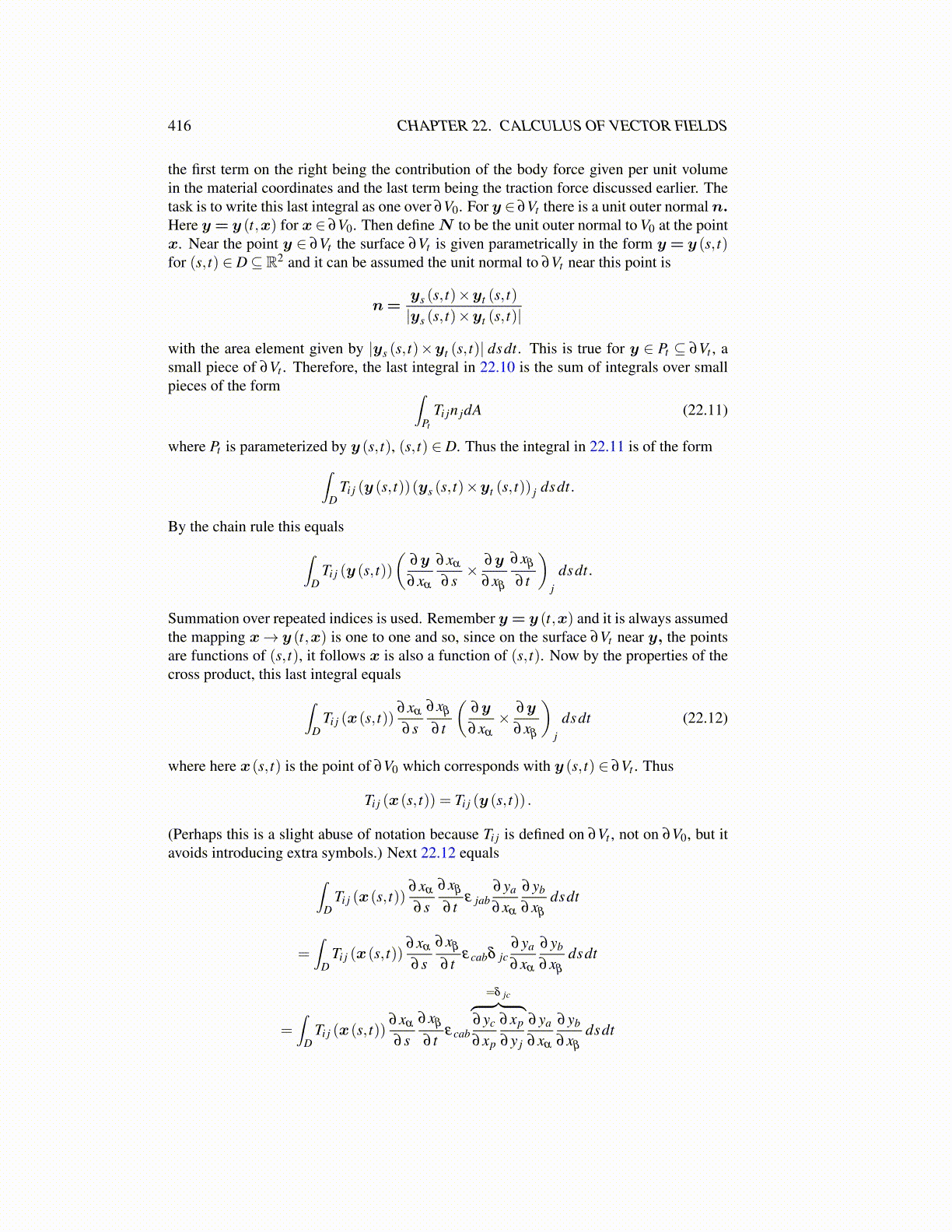
416 CHAPTER 22. CALCULUS OF VECTOR FIELDS
the first term on the right being the contribution of the body force given per unit volumein the material coordinates and the last term being the traction force discussed earlier. Thetask is to write this last integral as one over ∂V0. For y ∈ ∂Vt there is a unit outer normal n.Here y = y (t,x) for x ∈ ∂V0. Then define N to be the unit outer normal to V0 at the pointx. Near the point y ∈ ∂Vt the surface ∂Vt is given parametrically in the form y = y (s, t)for (s, t) ∈ D⊆ R2 and it can be assumed the unit normal to ∂Vt near this point is
n=ys (s, t)×yt (s, t)|ys (s, t)×yt (s, t)|
with the area element given by |ys (s, t)×yt (s, t)| dsdt. This is true for y ∈ Pt ⊆ ∂Vt , asmall piece of ∂Vt . Therefore, the last integral in 22.10 is the sum of integrals over smallpieces of the form ∫
Pt
Ti jn jdA (22.11)
where Pt is parameterized by y (s, t), (s, t) ∈ D. Thus the integral in 22.11 is of the form∫D
Ti j (y (s, t))(ys (s, t)×yt (s, t)) j dsdt.
By the chain rule this equals∫D
Ti j (y (s, t))(
∂y
∂xα
∂xα
∂ s× ∂y
∂xβ
∂xβ
∂ t
)jdsdt.
Summation over repeated indices is used. Remember y = y (t,x) and it is always assumedthe mapping x→ y (t,x) is one to one and so, since on the surface ∂Vt near y, the pointsare functions of (s, t), it follows x is also a function of (s, t). Now by the properties of thecross product, this last integral equals∫
DTi j (x(s, t))
∂xα
∂ s∂xβ
∂ t
(∂y
∂xα
× ∂y
∂xβ
)jdsdt (22.12)
where here x(s, t) is the point of ∂V0 which corresponds with y (s, t) ∈ ∂Vt . Thus
Ti j (x(s, t)) = Ti j (y (s, t)) .
(Perhaps this is a slight abuse of notation because Ti j is defined on ∂Vt , not on ∂V0, but itavoids introducing extra symbols.) Next 22.12 equals∫
DTi j (x(s, t))
∂xα
∂ s∂xβ
∂ tε jab
∂ya
∂xα
∂yb
∂xβ
dsdt
=∫
DTi j (x(s, t))
∂xα
∂ s∂xβ
∂ tεcabδ jc
∂ya
∂xα
∂yb
∂xβ
dsdt
=∫
DTi j (x(s, t))
∂xα
∂ s∂xβ
∂ tεcab
=δ jc︷ ︸︸ ︷∂yc
∂xp
∂xp
∂y j
∂ya
∂xα
∂yb
∂xβ
dsdt